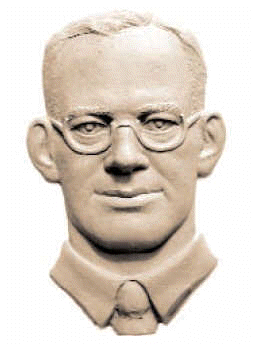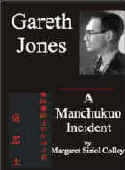Gareth Jones
[bas relief by Oleh Lesiuk]
HOME |
Stop Press |
Complete Soviet Articles & Background Information |
Précis of Gareth's
|
All Published Articles |
BOOKS
|
|
|
|
More Than Grain of Truth(2005) |
|
|
TOPICAL
'Are you Listening NYT?' U.N. Speech - Nov 2009 |
Gareth Recognised at Cambridge - Nov 2009 |
Reporter and the Genocide - Rome, March 2009 |
Order of Freedom Award -Nov 2008 |
Premiere of 'The Living' Documentary Kyiv - Nov 2008 |
Gareth Jones 'Famine' Diaries - Chicago 2008 |
Aberystwyth Memorial Plaque 2006 |
GENERAL
Scholarship Fund |
Site Map |
Links |
Legal Notices |
Sponsored Links |
Contact |
ThHTTP/1.1 100 Continue e Financial News, Thursday, April 13th 1933
BALANCE-SHEET OF THE FIVE-YEAR PLAN
- - - - -
III - RUIN OF RUSSIAN AGRICULTURE
---
By Gareth Jones
THE main result of the Five-Year Plan has been the ruin of Russian agriculture, a fact which completely outbalances the achievements of Soviet industry and is already gravely affecting the industrialisation of the country. In the eyes of responsible foreign observers and of peasants, the famine in Russia to-day is far worse than that of 1921. In 1921 the famine was spread over wide areas, it is true, but, in comparison with the general famine throughout the country which exists to-day, it might be considered localised. In 1921 the towns were short of food, but in most parts of the Ukraine and elsewhere there was enough bread, and the peasants were able to live. To-day there is food in the towns although in the provinces not enough whereas the countryside has been stripped of bread.
Symptomatic of the collapse of Russian agriculture is the shooting of thirty-five prominent workers in the Commissariat of Agriculture and in the Commissariat of State Farms, including the Vice-Commissar of Agriculture himself, and Mr. Wolff, whose name is well known to foreign agricultural experts. They were accused of smashing tractors, of burning tractor stations and flax factories, of stealing grain reserves, of disorganising the sowing campaign and of destroying cattle. “Pravda “ (March 5) stated that “the activities of the arrested men had as their aim the ruining of agriculture and the creation of famine in the country.” Surely a formidable task for thirty-five men in a country which stretches 6,000 miles!
Sign of Panic
The shooting of thirty-five is a sign of the panic which has come over the Soviet regime on account of the failure of collectivisation. The writer has visited villages in the Moscow district, in the Black Earth district, and in North Ukraine, parts, which are far from being the most badly hit in Russia. He has collected evidence from peasants and foreign observers and residents concerning the Ukraine, Crimea, North Caucasia, Nijni-Novgorod district, West Siberia, Kazakstan, Tashkent area, the German Volga and Ukrainian colonists, and all the evidence proves that there is a general famine threatening the lives of millions of people. The Soviet Government tries its best to conceal the situation, but the grim facts will out. Under the conditions of censorship existing in Moscow, foreign journalists have to tone down their messages and have become masters at the art of understatement. The existence of the general famine is none the less true, in spite of the fact that Moscow still has bread.
What are the causes of the famine? The main reason for the catastrophe in Russian agriculture is the Soviet policy of collectivisation. The prophecy of Paul Scheffer in 1929-30 that collectivisation of agriculture would be the nemesis of Communism has come absolutely true. Except for drought in certain areas, climatic conditions have blessed the Soviet Government in the last few years. Then why the catastrophe?
Passive Resistance
In the first place, the policy of creating large collective farms, where the land was to be owned and cultivated in common, led to the land being taken away from more than two-thirds of the peasantry, and incentive to work disappeared. Moreover, last year nearly all the crops were violently seized, and the peasant was left almost nothing for himself. The passive resistance of the peasant has been a far more important factor in Russian development than the ability to cook statistics.
In the second place, the massacre of cattle by peasants not wishing to sacrifice their property for nothing to the collective farm, the perishing of horses through lack of fodder, the death of innumerable livestock through exposure, epidemics and hunger on those mad ventures, the cattle factories, have so depleted the livestock of the Soviet Union that not until 1945 could that livestock reach the level of 1928. And that is, provided that all the plans for import of cattle succeed, provided there is no disease, and provided there is fodder. That date 1945 is given by one of the most reliable foreign agricultural experts in Moscow. In all villages visited by the writer most of the cattle and of the horses bad been slaughtered or died of lack of fodder, while the remaining horses were scraggy and diseased.
In the third place, six or seven millions of the best workers (the Kulaks) have been uprooted and deprived of their land. Apart from all consideration of human feelings, the existence of many millions of good producers is an immense capital value to any country, and to have destroyed such capital value means an inestimable loss to the national wealth of Russia. Although two years ago the Soviet authorities stated that they had liquidated the Kulak as a class, the drive against the better peasants was carried on with renewed violence last winter.
The final reason for the famine in the Soviet Union has been the export of foodstuffs. For this it is not so much the Soviet Government as the world crisis, which is to blame. The crash in world prices has been an important factor in creating the grave situation in Russia. Prices have dropped most in precisely those products, wheat, timber, oil, butter, &c., which the Soviet Union exports, and least in those products, such as machinery, which the Soviet Union imports. The result has been that Russia has had to export increased quantities at lower value.
What of the Future?
What of the future? In order to try and gauge the prospects for the next harvest, the writer asked in March the following questions in each village:
(1) Have you seed?
(2) What will the spring sowing be like?
(3) What were the winter sowing and the winter ploughing like?
(4) What do you think of the new tax?
On the question of seed, several villages were provided with seed, but many lacked seed. Experts are confident that the Government has far greater reserves of grain than in 1921, but evidence points to a lack of seed in certain areas.
Peasants were emphatic in stating that the spring sowing would he bad. They stated that they were too weak and swollen to sow, that there would be little cattle fodder left for them to eat in a month’s time, that there were few horses left to plough, that the remaining horses were weak, that the tractors, when they had any, stopped all the time, and, finally, that weeds might destroy the crops.
Information received concerning the winter sowing and the winter ploughing was black. There had been little winter sowing, which accounts for about one-third of the total crops, and winter ploughing had been bad. The winter sowing had been very late.
On the question of the Soviet Government’s new agricultural policy, peasants were also doubtful. The new tax, by which the collective farms will pay so much grain (usually about 2 and half centners) per hectare and be free to sell, the rest on the open market, is not likely to make much difference to the situation, for the peasants have completely lost faith in the Government.
The outlook for the next harvest is, therefore, black. It is dangerous to make any prophecy, for the miracle of perfect climatic conditions can always make good a part of the ‘unfavourable factors.
The chief fact remains, however, that in building up industry the Soviet Government has destroyed its greatest source of wealth - its agriculture.
This is the concluding article of a series of three; the first appeared in our Issue of Tuesday and the second yesterday.
|
|
|
|



